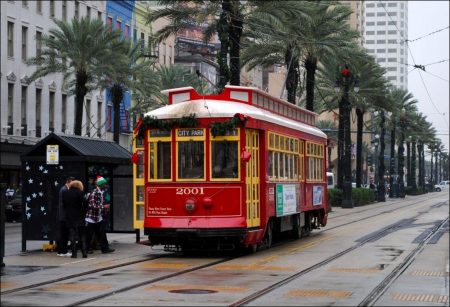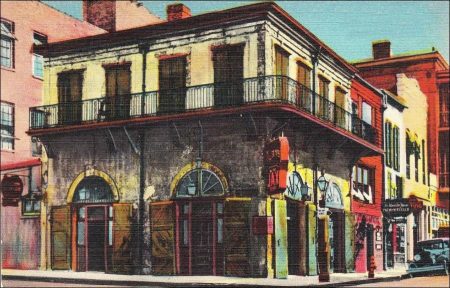The new settlement superseded Biloxi in 1723 as the capital of the vast Colonial empire of Louisiana. Eighteen miles of levee were constructed above and below the town, government buildings erected, and efforts made to drain the land. As part of the ‘Mississippi Bubble,’ John Law’s grandiose real-estate project, New Orleans enjoyed an early increase in population, although the majority of immigrants coming to Louisiana in quest of the easy living advertised in Europe chose to settle along the river outside of the small town.
Beside the civil and military officials, the population consisted of slaves, soldiers, trappers, and merchants. Classes of slaves included Negroes imported directly from Africa or from the French possessions in the West Indies; esclaves naturels, Indian prisoners of war; and ‘redemptioners,’ impoverished Europeans, most of whom were Germans, who had bound themselves to serve for a period of three years in payment of their passage and were ‘sold’ to the planters by ship captains. Because of the rapid increase in slaves, the French practice of populating Louisiana with convict labor soon came to a stop, resulting in an improvement in the type of colonist settling in and about New Orleans.
Under the Company of the Indies, a John Law enterprise, the government of the Colony was vested in a Superior Council consisting of the directors of the trading company with a commandant-general, in place of a governor, at its head. Lower courts were established for the administration of justice, and a right of appeal to the Superior Council was granted.
In 1724, the Code Noir, a compilation drawn up for the regulation of Negroes on the island of Santo Domingo, was promulgated in Louisiana by Governor Bienville. Among its additional provisions were those having to do with the expulsion of Jews from the province, under penalty of confiscation of property and imprisonment, and the establishment of the Catholic religion as the State faith. For more than a century it formed the basis of white treatment of enslaved Negroes.
The religious administration of the Colony was divided among three religious orders. The Jesuits were given charge of all territory north of the Ohio, the Capuchins were assigned to the territory west of the Mississippi River, and the Carmelite Fathers were placed in charge of the settlement east of the river with headquarters at Mobile. The Carmelites failed to fill their assignment and the Capuchins were given charge, while the Jesuits were allowed to do missionary work among the Indians in the Capuchin territory, with the understanding that there would be no interference with Capuchin activities. Both orders were under the supervision of the Bishop of Quebec.
Care for the sick and education for girls were provided for with the arrival in 1727 of six Ursuline nuns, who founded the Ursuline Convent. Equally important, however, was the importation during the following years of young French women (called filles à la cassette because of the chests of clothes and linen given them as dowries by the French Government) to supply wives for the colonists.
In 1731 the Company of the Indies relinquished its charter and Louisiana once more became a province of the Crown. A governor, appointed by the King as his representative, regulated the simple affairs of the Colony, and in his executive capacity exercised military and administrative authority, enforced by the soldiery of which he was the head. His dictatorial power also embraced judicial and legislative activity, limited to a great extent, however, by the fact that all ordinances and royal edicts emanated from France.
The Superior Council was reorganized to consist of the intendant, procureur-général (King’s attorney), registrar of the province, and six prominent citizens. In conjunction with the Governor and a commissaire ordonnateur (agent of the King in charge of commerce and Crown property) the Council discharged the executive, legislative, and judicial affairs of the Colony. Justice was administered, without trial by jury, by inferior courts subject to the appellate jurisdiction of the Superior Council. The Custom of Paris, a codification of ancient French law, formed the basis of Colonial law from the beginning.
Early in its history the town took on a gay and light-hearted appearance. Under the governorship of the Marquis de Vaudreuil ( 1743-53) the social life of the town was modeled after Versailles, and citizens sought to outdo each other in the splendor of their social affairs.
The capital of one third of the present area of the United States grew slowly. At first only that manufacturing which had to do with supplying the immediate needs of the Colony was undertaken. Sawmills were in operation soon after the town was founded, and by 1729 brick, pottery, and tiling were being sold in New Orleans. Shipbuilding, especially the construction of pirogues, brigantines, and other small craft, developed as an industry to meet the demands of growing commerce on the Mississippi.
Never fully realizing her importance as the port of the Mississippi Valley, New Orleans lay dormant during the first half of the eighteenth century. Trade restrictions prohibited commerce with any but the mother country, and illegal trade with England, Spain, Mexico, Florida, and the West Indies had to be resorted to. With merchants and officials conniving with smugglers and pirates, smuggling grew to such an extent that in 1763 the illicit traffic was estimated to represent one sixth of the official trade total. The bulk of cargoes, shipped in exchange for slaves and European merchandise, consisted of lumber, pitch, tar, wax from the wax myrtle, brick, rice, indigo, sugar cane, cotton, sassafras, and fur pelts.
As settlers crossed the Allegheny Mountains and developed the Middle West, New Orleans began to grow as a commercial port. The extent to which the river traffic had grown by 1750 may be seen in the frequent requests of Colonial officials for sailors to man the boats used on the river. By 1763 exports totaled $304,000; indigo accounted for $100,000, skins and furs $80,000, and lumber $50,000.
Views: 225




